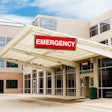Dear AuntMinnie Member,
Imaging utilization rates remain stubbornly high in the emergency setting, according to a study presented at last week's RSNA 2015 meeting.
Researchers from Thomas Jefferson University wanted to investigate previous findings that recorded a slowdown in CT and MRI use in the emergency department (ED) at a single facility from 2007 to 2012. Was the declining growth rate confined to a single site, or was it emblematic of a broader trend?
In the paper presented last week, the researchers found that the growth in imaging use has indeed continued apace across the Medicare system. CT led the charge with growth of 229% from 2001 to 2013. Read more about this study by clicking here, or visit our Imaging Leaders Community at leaders.auntminnie.com.
False positives and cancer
In another new study, researchers from the University of North Carolina found that women who have received a false-positive finding on a mammogram have a 40% higher risk of breast cancer later in life -- even though the initial finding proved to be benign.
The results suggest that false positives could represent cases in which radiologists detected suspicious findings that turned out to be benign but which might be precursors to cancer, according to the researchers. Will the study affect the debate over breast screening? Learn more by clicking here.
CAC and CT screening
Finally, visit our CT Community for another study from RSNA 2015 that found that analyzing coronary artery calcium (CAC) on CT lung screening scans could be an effective way of finding out who is at risk of future coronary events. The study could give CT lung screening an even greater edge as a cost-effective screening exam. Get the rest of the story by clicking here.



















